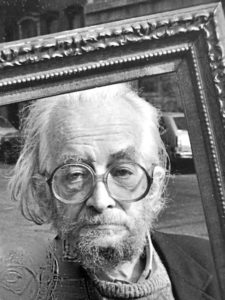To open our second season of Full Aperture, we present the work of an influential American filmmaker who in a sense can barely be called a filmmaker, such was the breadth of his work and interests. He collected and connected the low and the high, giving languages and folk art and hobbyist crafts serious study, curating folk songs into venerated collections. The magic of Harry Smith is that in seemingly every aspect of his life and work, he is ignorant of boundaries that are observed by most people: between seen and unseen, modern and ancient, sense and nonsense, complete and incomplete, wealth and destitution, true and false.
Born in Oregon to pantheist, folklorist parents, Smith’s broad array of passions happened to connect him with nonconformists on both coasts from early adulthood. He involved himself in recording folk and rock music (notably with the Fugs), cultivated a serious interest in the occult, researched and practiced various modes of mysticism, pursued serious interest in alchemy and altered states of consciousness, lived among tribal cultures, collected paper airplanes and other folk art objects, and a host of other activities that brought him into close contact with the Guggenheim Museum, the Smithsonian, Beat poets and hippies, and anyone living in the Chelsea Hotel as he frequently did throughout the second half of his life (people like Patti Smith, who paints an endearingly maniacal portrait of Harry in her book Just Kids).
Perhaps Harry Smith’s most significant cultural contribution was not a film, but the Anthology of American Folk Music. Smith compiled Anthology onto LPs from his massive collection of vintage 78s, in lieu of selling it to Folkways Records for much-needed funds. Anthology became a central catalyst for the folk revival that eventually inspired artists like Bob Dylan, and remains legendary.
By this time, Smith had been living on the West Coast and gathering inspiration from its avant-garde filmmakers to make his own films. Smith’s early films are seen most frequently, having been collected as Early Abstractions. (Perhaps because they occur early in the history of American avant-garde filmmaking, they’re a more convenient marker than his later work; maybe having more titles during this time indicates his most active or significant period; they’re also short and relatively accessible.) Some of the early films are kaleidoscopically entrancing animations that owe a lot to Oskar Fischinger, and to the kind of intense focus required for hand-painting and frame-by-frame animation.
Smith might have been interested in cinema as synesthesia – he sometimes spoke in synesthetic terms and painted abstractly along with bebop. He also placed great emphasis on contrasts between film sound and image, experimenting with all sorts of music to soundtrack his screenings. It has been suggested that Smith’s films focused on conscious and unconscious meanings, and the friction between different sensory inputs was one way to conjure meaning. I’d also guess that he was excited by the energy of abstract images paired with sound, especially in the mode of West Coast filmmakers like Jordan Belson and Kenneth Anger – seemingly spontaneous and complex and ecstatically overwhelming, like the bebop he loved. But Smith was not precious about his films themselves – he repeatedly re-edited them, presented them with a variety of soundtracks, employed ancillary projection elements like gels and superimpositions, and allegedly lost or destroyed plenty of work.
The history of Heaven and Earth Magic (also referred to as #12 by scholars for the sake of cataloguing) also fits this scattershot trajectory. Completed as early as 1957 and re-edited for several years, it wasn’t even given a name by Smith himself – Jonas Mekas named it in the mid-1960s. It’s rumored to have been up to six hours long at one point, and other versions ran to two hours. It’s unclear whether it was ever projected “as Smith intended,” which might have involved colored gels, superimpositions, and musical accompaniment replacing the film’s soundtrack of only effects. Regardless, Heaven and Earth Magic could be seen as Smith’s most narratively ambitious (if not most widely viewed) film.
Actually watching the film is to bathe in its quirky humor, symbolic ambivalence, and layers of imagery. Using mostly paper cutouts (which were also used in #8), Smith constructs surreal and absurd collage-objects and collage-beings. We see surreal mecha-humanoid figures, mannequins, and Victorian ladies. Certain objects recur and recur. There’s an element of performance, as if human characters – chiefly a man who seems to be a magician – are playing to the viewer (and the camera) on a filmed stage.
In terms of style, the film’s exaggerated movements suggest the herky-jerky hobbling of South Park and the naughty visual puns of Terry Gilliam. But, while crude, Smith’s beings definitely perform specific actions: there is real intention here. And while not biographical, the film alludes to many of Smith’s personal preoccupations – alchemy, transformation, and decoding systems of meaning – with densely layered reflections on their significance and relation to the self.
Or not. Smith himself described the film thus:
The first part depicts the heroine’s toothache consequent to the loss of a very valuable watermelon, her dentistry and transportation to heaven. Next follows an elaborate exposition of the heavenly land, in terms of Israel, Montreal and the second part depicts the return to Earth from being eaten by Max Muller on the day Edward the Seventh dedicated the Great Sewer of London.
Smith’s cryptic liner notes for Anthology have been described as “seemingly both timeless and avant-garde,” which might be a good description of Heaven and Earth Magic. One gets the impression of the film being simultaneously haphazard and meticulously done, dancing tantalizingly along the edge of meaning, perhaps uncaring whether or not it tumbles off the edge. This dance is the special gift of Harry Smith. (TB)




